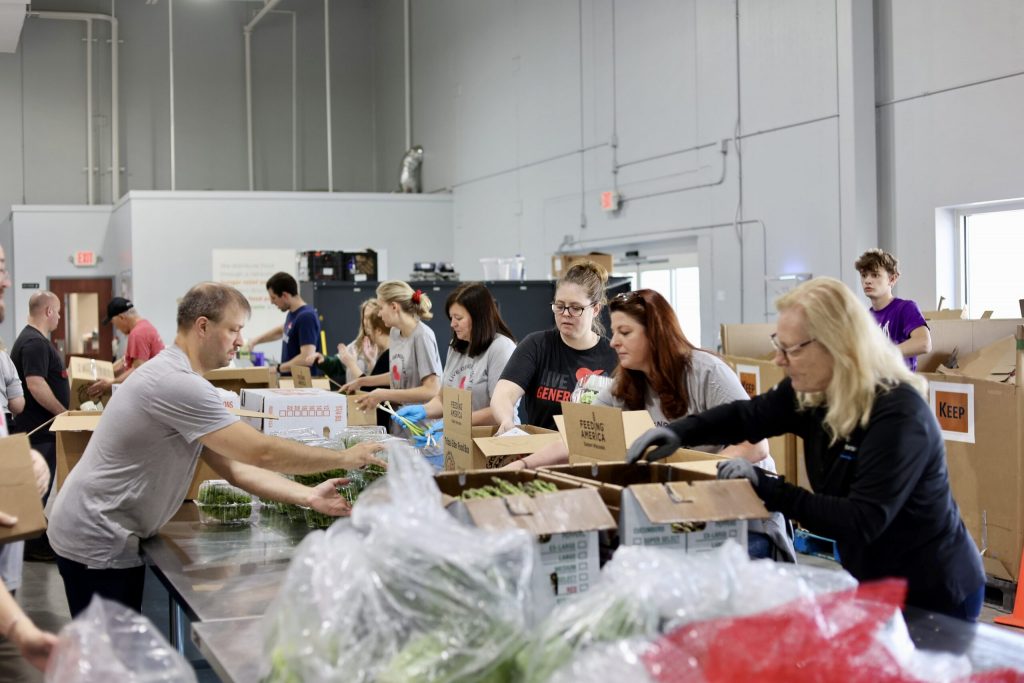‘The Greatest Spike of Childhood Hunger Since the Great Recession’
Wisconsin food banks face rising demand for food amid federal funding cuts.

Volunteers with Feeding America Eastern Wisconsin sort food to support those facing insecurity. Photo courtesy Feeding America Eastern Wisconsin
The demand for services from food pantries is on the rise in Wisconsin. At the same time, pantries are receiving less food, and cuts by the federal government are leaving them with less support.
Earlier this year, the Trump administration eliminated a pair of hunger relief programs run by the U.S. Department of Agriculture, worth about $1 billion in federal funding. That is about half of what the group Feeding America projected the government would spend on hunger relief efforts this year.
On WPR’s “Wisconsin Today,” Matt Stienstra of Feeding America Eastern Wisconsin said the demand for the organization’s 370 food pantries has increased by 30 percent since 2023.
The most recent report from the U.S Department of Agriculture regarding food insecurity shows 13.5 percent of American households were food insecure in 2023.
“We’re in the middle of the greatest spike of childhood hunger since the Great Recession,” said Stienstra, the Wisconsin group’s director of advocacy and community engagement.
According to the group, one in six children face hunger in Wisconsin.
Less federal funding for hunger relief could also affect farmers. In 2023, Wisconsin farmers received about $11.5 million in federal money to support local pantries. This year’s cancelled funding would have amounted to $17 million.
“We formed tremendous partnerships over the past few years through these programs where we’re able to source food from farmers,” he said.
Stienstra said Feeding America Eastern Wisconsin has a partnership with the Wisconsin Food Hub Cooperative, a farmer-led group, to ensure their crops continue to be delivered to communities in need.

Feeding America Eastern Wisconsin delivered more than 38 million pounds of food from July 2023 to June 2024 to those in need. Photo courtesy Feeding America Eastern Wisconsin
“Almost 12 of the farmers have lost that ability,” he said. “We picked up those relationships to figure out how to support farmers.”
Stienstra said despite the recent funding loss, Feeding America Eastern Wisconsin recognizes that this is part of a bigger problem that began in 2022.
“Wisconsin has already lost more than a billion dollars in federal benefits and commodities that go directly to food pantries and families in need,” he said.
Dane County food pantry sees ‘record’ demand, while product availability decreases
In Dane County, Leslie Albrecht Huber is seeing a sharp rise in people using the food pantry at WayForward Resources in Middleton. The nonprofit organization offers a clothing center, housing stability and food pantry services.
“We have three times as many visits as we did just two years ago,” she said.
Huber said last year about half of the pantry’s visitors were first-time users, while 75 percent of users were families with children.
For WayForward Resources, federal funding losses and rising grocery prices mean the group will procure about 20 percent less of its food from the Second Harvest Foodbank of Southern Wisconsin than it has in the past.
“People are leaving with less because there’s simply less food available on the shelves,” she said.
Despite the ongoing gap in federal funding, she said the group will continue its mission to serve.
“We never turn anyone away,” she said.
Community advocacy surrounding Wisconsin food banks
Stienstra agrees that the state of grocery prices is hurting the supply chain for food banks.
“Food coming to pantries has dropped precipitously over the past few years,” he said.
Huber said WayForward Resources is working with Feeding Wisconsin, the state association of food banks, to request more than $30 million to support food banks through the 2025-27 state budget.
“Wisconsin is one of a handful of states that doesn’t provide that now, and with the growing need, we feel like that is going to be imperative,” she said.
Earlier this month, Feeding America announced “The Next Billion Meals Challenge,” a 10-year initiative to provide an additional one billion meals to those in need.
Stienstra said the regional chapter will “absolutely” participate as Wisconsin has a very rich history of supporting its own communities, its own neighbors.
“Our mission is to solve hunger, but oftentimes we switch from solving hunger to serving,” he said. “This is one of those times where we have to pivot.”
Huber mentioned that WayForward Resources is already bringing awareness to Dane County food insecurity through in-person education sessions.
“We invite people to talk to them about what’s going on with food,” Huber said. “When people have that information, they are more empowered to act and to support our work.”
Wisconsin food banks are facing dual challenges of federal losses and increasing demand was originally published by Wisconsin Public Radio.
If you think stories like this are important, become a member of Urban Milwaukee and help support real, independent journalism. Plus you get some cool added benefits.




















